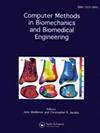分析同心和偏心动态肌肉收缩的单个共同窗口的重要性:揭示肌电图数据和运动单元库的组成部分。
IF 1.7
4区 医学
Q3 COMPUTER SCIENCE, INTERDISCIPLINARY APPLICATIONS
Computer Methods in Biomechanics and Biomedical Engineering
Pub Date : 2024-11-01
DOI:10.1080/10255842.2024.2422900
引用次数: 0
摘要
本研究提出了一种分析分解肌电信号的方法,以增强运动单元(MU)的特征描述。该方法包括两个步骤(i) 根据发射率(FR)、招募阈值和运动单元动作电位振幅对运动单元进行分组,以及 (ii) 在感兴趣的时间对数据进行分割。这种方法能够区分不同的运动单元组,有助于理解肌肉力量的产生。研究了膝关节伸展过程中外展肌和股直肌的肌阵挛。研究结果区分了 MU 组别,并揭示了以下方面的差异:两种收缩类型之间的阻力分布;分组;以及两种收缩类型中的分段 MU 数据。本文章由计算机程序翻译,如有差异,请以英文原文为准。
The importance of analysing a single common window of a concentric and eccentric dynamic muscle contraction: unveiling the components of EMG data and motor unit pool.
This study proposes a method for analysing decomposed electromyographic signals to enhance the characterization of motor units (MU). It involves two steps: (i) clustering groups of motor units based on firing rate (FR), recruitment threshold, and MU action potential amplitude, and (ii) segmentation of data at the time of interest. Such method, capable of distinguishing different groups of MU, could help understanding muscle force production. FR of MU in Vastus Lateralis and Rectus Femoris during knee extension was investigated. The findings distinguish MU groups and reveals differences in: FR between both contractions types; clustered groups; and segmented MU data in both contraction types.
求助全文
通过发布文献求助,成功后即可免费获取论文全文。
去求助
来源期刊
CiteScore
4.10
自引率
6.20%
发文量
179
审稿时长
4-8 weeks
期刊介绍:
The primary aims of Computer Methods in Biomechanics and Biomedical Engineering are to provide a means of communicating the advances being made in the areas of biomechanics and biomedical engineering and to stimulate interest in the continually emerging computer based technologies which are being applied in these multidisciplinary subjects. Computer Methods in Biomechanics and Biomedical Engineering will also provide a focus for the importance of integrating the disciplines of engineering with medical technology and clinical expertise. Such integration will have a major impact on health care in the future.

 求助内容:
求助内容: 应助结果提醒方式:
应助结果提醒方式:


